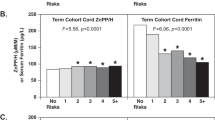Objectives: Iron deficiency is the most common nutrient deficiency in pregnant women and has been linked to negative impacts on the fetus. We describe the association of various iron-deficiency indices with risk of neural tube defect (NTD) among a high-risk Mexican-American population. Methods: The study included 158 case-women (NTD-affected pregnancies) and 189 control-women (normal births) who were residents of the 14 Texas–Mexico border counties and delivered or terminated pregnancies during 1995–2000. In-person interviews and laboratory assays provided data. Results: Case-women had higher odds of having minimal or no iron stores (serum ferritin <30 μg/L) compared to control-women (OR = 1.8, 95% CI = 1.0–3.3). The risk effect was not explained by low folate or B12 or other risk factors. Conclusion: Low serum ferritin may reflect the additive effect of multiple long-term factors, many of them related to poverty such as poor quality diet, lack of supplementation, and frequent pregnancies. Interpartum care is indicated in this population.
Similar content being viewed by others
REFERENCES
Lee GR. The anemias associated with renal disease, liver disease, endocrine disease, and pregnancy. In: Lee GR, Foerster J, Lukens J, Paraskevas F, Greer JP, Rodgers GM, editors. Wintrobe's clinical heamatology, Vol. 2. (10th ed.) Philadelphia, PA: Lippincott Williams and Wilkins, 1999:Chapter 57.
Hillman RS. Hematopoietic agents: Growth factors, minerals, and vitamins. In: Hardman JG, Limbird LE, (Eds.) Goodman & Gilman's the pharmacological basis of therapeutics. (10th ed.) New York: McGraw-Hill, 2001:Chapter 54.
Mason JB. Consequences of altered micronutrient status. In: Goldman L, Bennett JC, (Eds.) Cecil textbook of medicine, Vol. 2. (21st ed.) Philadelphia, PA: W.B. Saunders Company, 2000:Chapter 231.
King JC. The risk of maternal nutritional depletion and poor outcomes increased in early or closely spaced pregnancies. J Nutr 2003;133(5 Suppl.):1732S–6S.
McArdle HF, Danzeisen R, Fosset C, Gambling L. The role of the placenta in iron transfer from mother to fetus and the relationship between iron status and fetal outcome. Biometals 2003;16:161–7.
Kilbride J, Baker TG, Parapia LA, Khoury SA, Shuqaidef SW, Jerwood D. Anaemia during pregnancy as a risk factor for iron-deficiency anaemia in infancy: A case–control study in Jordan. Int J Epidemiol 1999;28:461–8.
Preziosi P, Prual A, Galan P, Daouda H, Boureima H, Hercberg S. Effect of iron supplementation on the iron status of pregnant women: Consequences for newborns. Am J Clin Nutr 1997;66:1178–182.
Black MM. Micronutrient deficiencies and cognitive functioning. J Nutr 2003;133(11 Suppl. 2):3927S–31S.
Hendricks KA, Simpson JS, Larsen RD. Neural tube defects along the Texas-Mexico border, 1993–1995. Am J Epidemiol 1999;149:1119–27.
Suarez L, Hendricks KA, Cooper SP, Sweeney AM, Hardy RJ, Larsen RD. Neural tube defects among Mexican Americans living on the US-Mexico border: Effects of folic acid and dietary folate. Am J Epidemiol 2000;152:1017–23.
McPherson RS, Kohl HW III, Garcia G, Nichaman MZ, Han CL. Food–frequency questionnaire validation among Mexican-Americans: Starr County, Texas. Ann Epidemiol 1995;5:378–95.
Van Den Broek NR, Letsky EA, White SA, Shenkin A. Iron status in pregnant women: Which measurements are valid? Br J Haematol 1998;103:817–24.
Suarez L, Hendricks K, Felkner M, Gunter E. Maternal serum B12 levels and risk for neural tube defects in a Texas-Mexico border population. Ann Epidemiol 2003;13:81–8.
Hendricks KA, Nuno OM, Suarez L, Larsen R. Effects of hyperinsulinemia and obesity on risk of neural tube defects among Mexican Americans. Epidemiology 2001;12:630–5.
Briefel RR, Flegal KM, Winn DM, et al. Assessing the nation's diet: Limitations of the food frequency questionnaire. J Am Diet Assoc 1992;92:959–62.
Byers T, Marshall J, Anthony E, et al. The reliability of dietary history from the distant past. Am J Epidemiol 1987;125:999–1011.
Delgado-Rodriguez M, Gomez-Olmedo M, Bueno-Cavanillas A, Garcia-Martin M, Galvez-Vargas R. Recall bias in a case–control study of low birth weight. J Clin Epidemiol 1995;48:1133–40.
Nutrition during pregnancy. Part I: Weight gain. Part II: Nutrition supplements. Washington, DC: Institute of Medicine, National Academy of Sciences, 1990.
Bodnar LM, Scanlon KS, Freedman DS, Siega-Riz AM, Cogswell ME. High prevalence of postpartum anemia among low-income women in the United States. Am J Obstet Gynecol 2001;185:438–43.
Bodnar LM, Cogswell ME, Scanlon KS. Low income postpartum women are at risk of iron deficiency. J Nutr 2002;132:2298–302.
Suarez L, Felkner M, Hendricks K. The effect of fever, febrile illnesses, and heat exposures on the risk of neural tube defects in a Texas-Mexico border population. Birth Defects Res (Part A) (in press).
Felkner M, Hendricks K, Suarez L, Waller DK. Diarrhea: A new risk factor for neural tube defects? Birth Defects Res (Part A) 2003;67:504–8.
Suarez L, Cardarelli K, Hendricks K. Maternal stress, social support, and risk of neural tube defects among Mexican Americans. Epidemiology 2003;14:612–6.
Rose G. Sick individuals and sick populations. Int J Epidemiol 1985;14:32–8.
Elwood M, Little J. Maternal age and reproductive history. In: Elwood JM, Little J, Elwood JH, (Eds.) Epidemiology and control of neural tube defects. Oxford: Oxford University Press, 1992.
Takashima S, Kuruta H, Mito T, et al. Immunohistochemistry of superoxide dismutase-1 in developing human brain. Brain Dev 1990;12(2):211–3.
Author information
Authors and Affiliations
Rights and permissions
About this article
Cite this article
Felkner, M.M., Suarez, L., Brender, J. et al. Iron Status Indicators in Women with Prior Neural Tube Defect-Affected Pregnancies. Matern Child Health J 9, 421–428 (2005). https://doi.org/10.1007/s10995-005-0017-3
Published:
Issue Date:
DOI: https://doi.org/10.1007/s10995-005-0017-3




